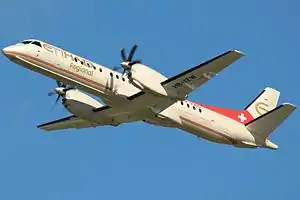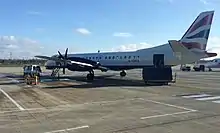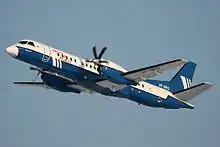Saab 2000
The Saab 2000 is a twin-engined high-speed turboprop airliner built by Saab. It is designed to carry 50–58 passengers and cruise at a speed of 665 km/h (413 mph). Production took place in Linköping in southern Sweden. The Saab 2000 first flew in March 1992 and was certified in 1994. The last aircraft was delivered in April 1999, a total of 63 aircraft being built. By July 2018, 24 Saab 2000s were in airline service.
| Saab 2000 | |
|---|---|
 | |
| Darwin Airline Saab 2000 in Etihad Regional livery taking off at Düsseldorf Airport in 2014 | |
| Role | Turboprop Regional airliner |
| Manufacturer | Saab |
| First flight | 26 March 1992 |
| Introduction | 30 August 1994[1] |
| Status | In service |
| Primary users | Eastern Airways PenAir |
| Produced | 1992–1999 |
| Number built | 63[2] |
| Developed from | Saab 340 |
Development and design
In December 1988, Saab decided to build a stretched derivative of its successful Saab 340 twin-turboprop regional airliner. The new aircraft was planned to meet a perceived demand for a high-speed 50-seat turboprop with good climb performance which could operate over short- and medium-range routes with similar block times to jet aircraft while retaining the efficiency provided by turboprop engines. The new airliner, called the Saab 2000, was formally launched in May 1989, with Saab already having firm orders for 46 aircraft and options for a further 147.[3] The aircraft was assembled at Saab's Linköping factory, with major subcontractors including CASA, who built the aircraft's wings, Short Brothers, who built the rear fuselage and Valmet who built the aircraft's tail surfaces.[4] The Saab 2000 first flew on 26 March 1992 and entered into scheduled airline service in September 1994, a few months after its certification by the Joint Aviation Authorities in March and the Federal Aviation Administration in April.[5][6]
The Saab 2000 has a 15% greater wingspan than the Saab 340,[3] and being 7.55 metres (24 ft 9 in) longer can carry up to 58 passengers in a high-density layout and 50 with a more comfortable 32 inches (81 cm) seat pitch.[5][3] The 2000 was the first commercial aircraft to use the Allison GMA 2100 turboprop engines, which are derated to 3,390 kW (4,550 shp) for the plane.[7] One engine was mounted on each wing, as in the 340, with the engines placed further from the fuselage than those of the 340 to reduce cabin noise.[3] The Dowty-Rotol propellers are 3.81 m (12.5 ft) in diameter, and they have a slow rotational speed of 1,100 rpm at takeoff and 950 rpm in cruise.[8]
Operational history

Sales of the Saab 2000 were fairly limited. The major initial customer was Crossair, a regional airline which had Swissair as a 56% shareholder. Crossair took delivery of 34 aircraft and was still operating the type in 2005.
Due to limited demand, Saab ceased production of the Saab 2000 in 1999, with the last aircraft being delivered to Crossair on 29 April of that year.[9] The primary reason for the low sales was the success of newly introduced regional jets such as the Bombardier CRJ and Embraer ERJ 145 family which provided better performance and passenger comfort for the same initial price.
General Motors (GM) operated several corporate-configured Saab 2000s and was in talks with new startup air carrier Pro Air to have this airline operate them in scheduled service as Pro Air Express in the U.S.; however, Pro Air then encountered financial difficulties and ceased all operations before the deal could be consummated. Air Marshall Islands also operated a Saab 2000 in the remote Micronesia island region of the Pacific Ocean.
Some smaller airlines, including Eastern Airways in the UK, have subsequently acquired 2000s at low cost and operated them on regional routes which experience lower passenger numbers as well on shuttle services in the U.K. for oil and gas personnel working in the North Sea.
In June 2006, Pakistan completed the purchase of six Saab 2000 turboprop aircraft to be equipped with the Saab-Ericsson ERIEYE Airborne Early Warning system. Revised in May 2007 due to renegotiation with the Government of Pakistan, only five aircraft will be delivered, four of which will be equipped with the Erieye system. On 3 April 2008, the first Saab 2000 Erieye AEW&C was rolled out and presented to Pakistan Air Force officials during a ceremony in Sweden.[10]

As of 2017, the only operator of the Saab 2000 in scheduled passenger operations in the U.S. is PenAir flying code sharing service on behalf of Alaska Airlines between Ted Stevens Anchorage International Airport (ANC) and several destinations in the state of Alaska.[11]
By July 2018, 24 Saab 2000s were in airline service.[12]
Variants
- Saab 2000: 50–58 seat regional airliner.
- Saab 2000FI: Flight inspection aircraft for the Japan Civil Aviation Bureau, two produced.
- Saab 2000 AEW&C: Airborne early warning and control variant fitted with Erieye active electronically scanned array radar and associated mission systems.
- Saab 2000 Airtracer: SIGINT aircraft
- Saab 2000 MPA: Maritime patrol aircraft
Operators
Civilian operators


As of September 2020, a total of 6 Saab 2000s remained in civilian airline service, operated by:
- Eastern Airways (1)
- FlexFlight (operated by Nyx Air).
Government operators
Former airline operators
The following airlines formerly operated Saab 2000 aircraft in scheduled passenger service in the past:[14]
- PenAir
- SkyWork Airlines
- Air France (operated by CityJet and Regional Airlines)
- Air Marshall Islands
- Braathens Regional
- Carpatair
- Crossair
- Adria Airways Switzerland (6) (operated by Darwin Airline)
- Deutsche BA
- Flybe
- FlyLAL
- Golden Air
- Loganair
- Malmo Aviation
- Moldavian Airlines
- OLT Express Germany
- PGA Portugália Airlines (operated by OMNI Aviation)
- Polet Airlines
- Scandinavian Airlines (operated by Braathens Regional)
- Scandinavian Commuter (operated by Swelink)
Specifications

Data from Brassey's World Aircraft & Systems Directory 1999/2000[5]
General characteristics
- Crew: 2
- Capacity: 50–58 passengers / 5,900 kg (13,007 lb) payload
- Length: 27.28 m (89 ft 6 in)
- Wingspan: 24.76 m (81 ft 3 in)
- Height: 7.73 m (25 ft 4 in) [4]
- Wing area: 55.7 m2 (600 sq ft)
- Airfoil: root: NACA MS(1)-0316; tip: NACA MS(1)-0312[15]
- Empty weight: 13,800 kg (30,424 lb)
- Max takeoff weight: 22,800 kg (50,265 lb)
- Powerplant: 2 × Rolls-Royce AE 2100P turboprop engines, 3,096 kW (4,152 hp) each
- Propellers: 6-bladed Dowty Propellers constant-speed composite fully feathering and reversible-pitch propellers
Performance
- Cruise speed: 665 km/h (413 mph, 359 kn)
- Range: 2,869 km (1,783 mi, 1,549 nmi)
- Service ceiling: 9,450 m (31,000 ft)
- Rate of climb: 11.4 m/s (2,240 ft/min)
Avionics
- Rockwell Collins Pro Line 4 avionics suite with integrated avionics processor (IAP)
Accidents and incidents
- On 8 October 1999, while being taxied by two technicians, the aircraft named "Eir Viking" crashed into closed hangar doors at Arlanda airport in Sweden. The plane was damaged beyond repair.
- On 10 July 2002, Crossair Flight 850, operated with a Saab 2000, was forced to make an emergency landing at Werneuchen Airfield, Germany, as a result of severe weather. One of the sixteen passengers on board suffered minor injuries. The aircraft, registered as HB-IZY, was damaged beyond economic repair when it hit an earth bank placed across the runway, the markings of which did not conform to standards.[16]
- On 17 October 2019, PenAir Flight 3296 went off the runway while landing at Unalaska Airport in Unalaska, Alaska. The United States National Transportation Safety Board is investigating the incident.[17] At least 1 person died and 10 were injured.
See also
Related development
Aircraft of comparable role, configuration, and era
- Antonov An-140
- ATR 42
- CASA/IPTN CN-235
- DHC-8-300
- Fokker 50
- Xian MA60
Related lists
References
- Citations
- "Delivery of first Saab 2000 to Crossair marks manufacturer milestone". Commuter Regional Airline News. Vol. 12 no. 35. 5 September 1994. p. 2. ISSN 1040-5402 – via Gale Research.
- "World Airliner Census". Flight International, Volume 184, Number 5403, 13–19 August 2013, pp. 40–58.
- Wheeler, Barry. "SAAB 2000: An exercise in growth and commonality" Air International, Volume 44, Number 2, February 1993. pp. 65–70. ISSN 0306-5634
- Lambert, Mark. Jane's All The World's Aircraft 1993–94. Coulsdon, UK: Jane's Data Division, 1993. ISBN 0-7106-1066-1. pp. 351-356.
- Taylor, Michael J. H. Brassey's World Aircraft & Systems Directory 1999/2000. London: Brassey's, 1999. ISBN 1-85753-245-7. pp 231–232.
- Moxon, Julian. "Crossair is pleased with Saab 2000 in service". Flight International, Volume 146, Number 4443, 19–25 October 1994, p. 10. ISSN 0015-3710
- Leyes, Richard A., II; Fleming, William A. (1999). The history of North American small gas turbine aircraft engines. Reston, VA: National Air and Space Museum and American Institute of Aeronautics and Astronautics (AIAA). p. 589. ISBN 1-56347-332-1. OCLC 247550535.
- George, Fred (March 1992). "Saab 2000: Fastest turboprop regional rolls out". Flying. Vol. 119 no. 3. p. 56. ISSN 0015-4806.
- "Commercial Aircraft Directory - Saab 2000". Flightglobal. Archived from the original on 17 May 2013.
- Update, Defense. "Saab Debut '2000 Special Mission Aircraft at Farnborough". Archived from the original on 23 February 2009. Retrieved 1 July 2009.
- https://www.alaskaair.com, Flight schedules for Anchorage
- "World Airline Census 2018". Flightglobal.com. Retrieved 26 August 2018.
- http://www.airliners.net, photos of Japan Civil Aviation Bureau Saab 2000 aircraft
- http://www.airliners.net, photos of Saab 2000 aircraft
- Lednicer, David. "The Incomplete Guide to Airfoil Usage". m-selig.ae.illinois.edu. Retrieved 16 April 2019.
- "Report: Crossair SB20 at Werneuchen on Jul 10th 2002, landed before runway and impacted earth wall". Avherald.com. Retrieved 14 April 2013.
- Sutton, Joe. "A plane carrying a high school swim team goes off the runway in Alaska". CNN. Retrieved 18 October 2019.
Further reading
- Magnusson, Michael. Saab 340 & Saab 2000 – The Untold Story. Stockholm, Sweden: Aviatic Förlag, 2014. ISBN 978-9186642-051
- Julian Moxon, Allan Winn, Simon Elliott and Douglas Barrie (11 December 1991). "More than a stretch - SAAB 2000 described". Flight International.CS1 maint: uses authors parameter (link)
